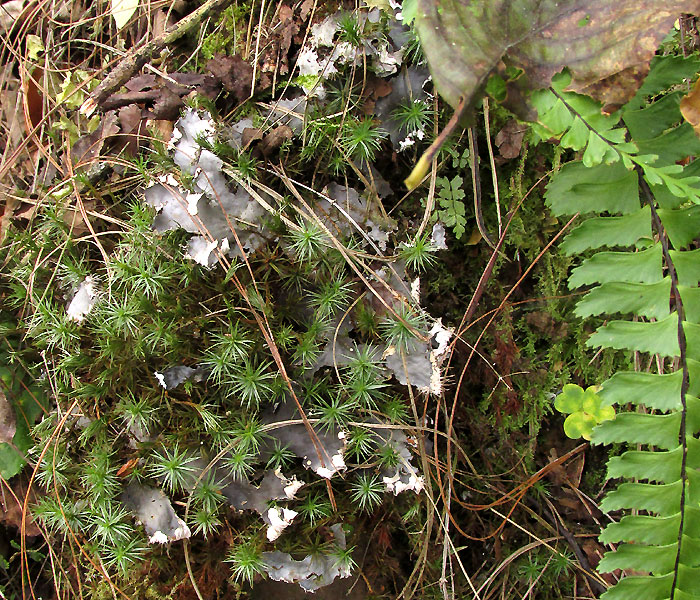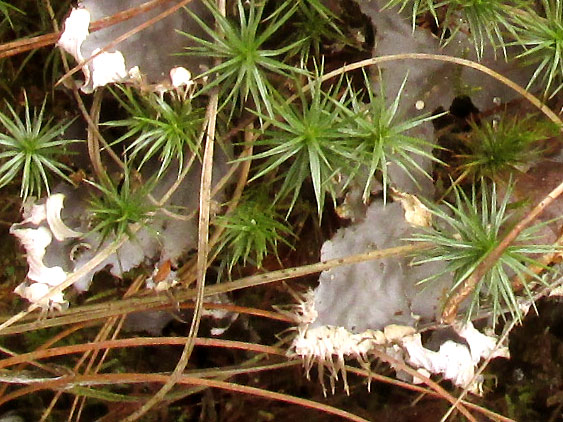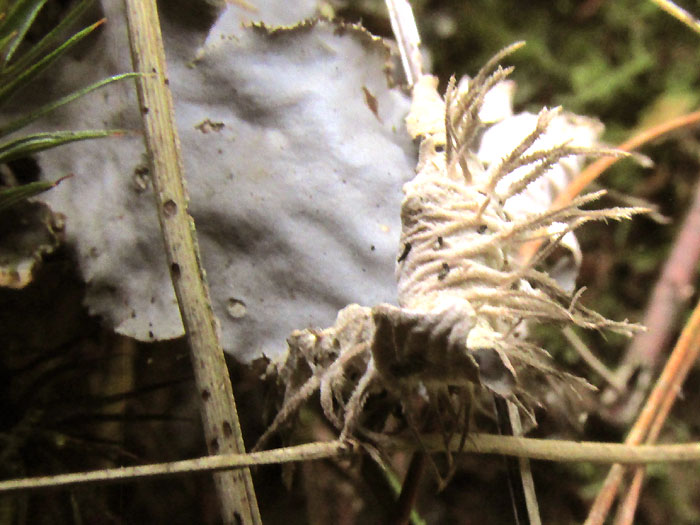Excerpts from Jim Conrad's
Naturalist Newsletter
entry from field notes dated January 19, 2023, taken along steep, one-lane gravel road ascending forested, northeast-facing mountain slope, elevation ±2,380m (7600 ft); bedrock of Cretaceous limestone; on the south side of Pinal de Amoles, Querétaro state, MÉXICO, (N21.134°, W99.629°)
DOG LICHEN

On the shady side of the mountain, on a north-facing roadcut, the flat, whitish leaves, or thalli, of the above foliose lichen grew among mosses. At the fern's right in the picture is the Single-Sorus Spleenwort, Asplenium monanthes. I'd seen a lichen very similar to this, also growing intimately among mosses, in the Siskiyou Mountains of Oregon. That had been the Ruffled Freckle Pelt Lichen, Peltigera leucophlebia. Above, arising from the white, upturned, thallus undersurfaces of the lichen branches in the picture's lower, right corner, notice white, root-like structures projecting into the air. Here's a closer look:

The root-like structures are called rhizines. I read that rhizines just anchor lichen thalli to the substrate they grow in, but the rhizines in the picture aren't rooted in anything, and are reminiscent of moisture-gathering air-roots on orchids and bromeliads. Note that this lichen's rhizines are white at their bases, becoming grayish in the middles, but with white tips. Also, in the above picture, notice at the bottom of a thallus in the image's lower, left corner a small patch of something brown. That's at least the beginning of the lichen's spore producing structure, the apothecium. Nearby, the same species displayed what's shown below:

The bushy items are more mature rhizines than seen above, bearing short hairlike items which in some places mat together with the hairs on other rhizines. In the above picture note that the bases of some rhizines are so close together that they touch one another. That helps identify this lichen to species level.
Relative to North America and Europe, Mexico's lichens aren't well documented. However, there's the 1976 study by María Elena Gonzáles de la Rosa and Gastón Guzmán entitled "Estudios Sobre los Liquenes de Mexico, III - Observaciones sobre Especies no Consideradas Anteriormente," which considers eight lichen genera occuring in Mexico, one of which is the genus Peltigera, like the very similar lichen seen in Oregon. The authors list six Peltigera species for Mexico, and a dichotomous key to the species is provided. Mostly on the basis of maps indicating exactly where each species has been collected, at the wonderful lichenportal.org website, and pictures and descriptions on the Internet, I'm calling our lichen PELTIGERA CANINA, often known as the Dog Lichen. I suspect that the name arises from its past usage in traditional medicine to cure rabies in dogs.
Peltigera canina distinguishes itself from other species occurring in Mexico by the foliose thalli's dull white upper surfaces, its brown and saddle-shaped appotheciea along the thallus margins, by the conspicuous rhizines arising very close together on the thallus undersurfaces, and -- not easily seen without magnification -- a carpet of very short hairs atop the thalli.
About 30 closely related Peltigera species with similar features cluster together in what's called the Peltigera canina Complex, which still hasn't been fully analyzed. It's assumed that certain species eventually will be lumped into Peltigera canina, and other new species may be recognized. Therefore, here well beyond the main locations where Peltigera canina has been collected in North America and western Europe, eventually our lichen may find its taxonomy shuffled around a bit.
Our Peltigera canina, like other lichens, is a composite organism. It consists of threadlike hyphae of a fungus, which provides the lichen body form and spores for reproduction, with cells of an alga and/or a cyanobacteria species, which photosynthesize food for for everyone in the lichen body. About a hundred species of cyanobacteria and algae, in about 40 genera, have been found forming lichens. In Peltigera canina, the photosynthesizing organism, or photobiont, partnering with the Peltigera canina fungus is a cyanobacterium in the genus Nostoc. In Texas we've documented the famous Nostoc commune, commonly known as Witch's Butter. Often fungal, algal and cyanobacteria species can live independently from one another, but other species are known to survive only in lichen bodies. Sometimes independently living species, under stress, unite to form lichens.
In the 2012 paper by C. Illana-Esteban entitled "Líquenes Usados en Medicina Tradicional," about lichens used in medicine, it's said that our Peltigera canina has been used traditionally to treat rabies. The thalli were dried, pounded into powder, and mixed with red pepper, reportedly curing dogs belonging to the Duke of York. In India, Peltigera canina has been used to cure liver diseases. Here in Mexico it's been used to treat amebiasis, an intestinal disease caused by the microscopic, parasitic protozoan Entamoeba histolytica.